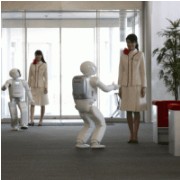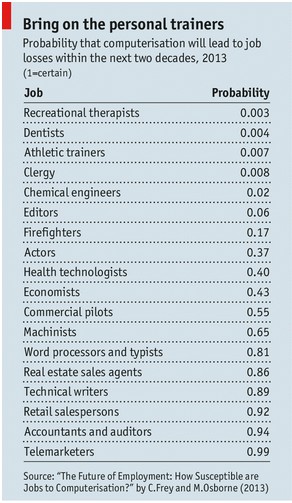
Last week, I posted an article examining a report from The Economist listing jobs that it believes are most at risk from computerisation (see below).

According to The Economist, accountants, economists, pilots, retailers, amongst others, are all in the firing line. Algorithms for big data are now entering domains reliant upon pattern recognition and can readily substitute for labour in a wide range of non-routine cognitive tasks. Many service occupations – from fast food counter attendants to medical transcriptionists – which have been a key driver of jobs growth over past decades, could all soon be replaced by automation.
Now The Atlantic has released a report of its own, arguing that nearly half of current jobs in the United States could be replaced by robots within a decade or two. Manufacturing, administrative support, retail, and transportation will continue to lose workers to automation – as has been the case for decades. However, cashiers, counter clerks, and telemarketers are equally endangered.
The report provides the below chart showing the probabilities of automation, with the jobs most at risk shown on the right and those least at risk on the left:

The Atlantic also provides the below chart showing the ten jobs with a 99% likelihood of being replaced by robots and software, which are typically routine-based tasks (telemarketing, sewing) or jobs that can be solved by smart algorithms (tax preparation, data entry, and insurance underwriters). At the bottom, the chart also lists the dozen jobs considered least likely to be automated, with health care workers, safety officials, and management positions dominating this list.

According to The Atlantic:
If you wanted to use this graph as a guide to the future of automation, your upshot would be: Machines are better at rules and routines; people are better at directing and diagnosing. But it doesn’t have to stay that way…
Predicting the future typically means extrapolating the past. It often fails to anticipate breakthroughs. But it’s precisely those unpredictable breakthroughs in computing that could have the biggest impact on the workforce…
We might be on the edge of a breakthrough moment in robotics and artificial intelligence…
If you go back to the two graphs in this piece to locate the safest industries and jobs, they’re dominated by managers, health-care workers, and a super-category that encompasses education, media, and community service. One conclusion to draw from this is that humans are, and will always be, superior at working with, and caring for, other humans…
But robots are already creeping into diagnostics and surgeries. Schools are already experimenting with software that replaces teaching hours. The fact that some industries have been safe from automation for the last three decades doesn’t guarantee that they’ll be safe for the next one…
It would be anxious enough if we knew exactly which jobs are next in line for automation. The truth is scarier. We don’t really have a clue.
If you are young person seeking a career, you would be well advised to begin looking at these new trends and studying The Economist’s and The Atlantic’s reports, and then hope that there are no technological breakthroughs that make your chosen vocation redundant.

